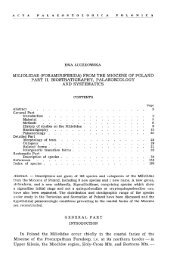Full text - Acta Palaeontologica Polonica
Full text - Acta Palaeontologica Polonica
Full text - Acta Palaeontologica Polonica
Create successful ePaper yourself
Turn your PDF publications into a flip-book with our unique Google optimized e-Paper software.
338 ACTA PALAEONTOLOGICA POLONICA 56 (2), 2011<br />
those of the fossil naticid shells by converging stripes and nu−<br />
merous zigzags with very variable amplitude as observed in<br />
the characteristic colour pattern of genus Globularia. Thus,<br />
this species is, here, excluded from Euspira and is placed<br />
within the family Ampullinidae, but only questionably placed<br />
in the genus Globularia, because of its lack of a sheath.<br />
Subgenus Cernina Gray, 1842<br />
Type species: Natica fluctuata Sowerby, 1825, Philippines, Recent.<br />
Globularia (Cernina) fluctuata (Sowerby, 1825)<br />
Fig. 5D, E.<br />
Stratigraphic and geographic range.—Recent (Philippines).<br />
Colour pattern description.—The pattern consists of four<br />
levels of colouration. The background is heterogeneous with<br />
broad spiral brown stripes. There are four brown stripes on<br />
the last whorl (Fig. 5D2,D3,E2): (i) one on the adapical part,<br />
(ii) one near the base, and (iii–iv) two stripes, slightly<br />
broader, on the median part. The apex is pale and there are<br />
white thin axial zigzagging stripes. The transition between<br />
the two levels of the background is diffuse. The axial zigzag−<br />
ging stripes are more or less parallel and present an irregular<br />
distribution on the shell. Some of these stop on the median<br />
part of the whorl (Fig. 5D2,E2). The amplitude of the zigzags<br />
varies. There is intraspecific variability in the number and<br />
density of the axial stripes.<br />
Comment.—The brown (darker) stripes correspond to the<br />
fluorescent (paler) stripes revealed under UV light in the fos−<br />
sil shells and the white axial zigzagging stripes are here con−<br />
sidered to correspond to the fluorescent zigzagging stripes.<br />
Globularia (Cernina) compressa (Basterot, 1825)<br />
Fig. 5F, G.<br />
Stratigraphic and geographic range.—Early Miocene, Aqui−<br />
tanian and Burdigalian–Middle Miocene, Langhian (AB, It−<br />
aly).<br />
Colour pattern description.—This species shows two levels<br />
of residual colouration (apex absent). The background is<br />
dark and homogeneous. There are thin axial fluorescent<br />
stripes. The thin axial stripes are very close to each other, but<br />
not parallel and form small zigzags (Fig. 5F1, G). Their distri−<br />
bution on the shell is variable (Fig. 5G) and the zigzags dis−<br />
play variable amplitude. The stripes sometimes branch in a<br />
dichotomous manner (Fig. 5F2). Globularia (Cernina) sp.<br />
Fig. 5H, I.<br />
Stratigraphic and geographic range.—Early Miocene, Aqui−<br />
tanian (AB).<br />
Colour pattern description.—These shells show two levels<br />
of residual colouration (apex absent): a dark and homoge−<br />
neous background and opisthocline thin fluorescent stripes<br />
(Fig. 5H, I). These opisthocline stripes are very close to each<br />
other, parallel and present a regular distribution. Their thick−<br />
ness is constant on the shell and they are barely sinuous.<br />
Comments.—All three specimens from Saint−Martin−d’Oney<br />
(France, AB) display the characteristic morphology of Glo−<br />
bularia (Cernina) compressa but the coloured pattern differs<br />
by the presence of opisthoclines, barely sinuous, thin stripes<br />
instead of axial zigzagging stripes (Fig. 5F, G). In our view,<br />
these differences do not result from intraspecific variability<br />
and justify these shells as belonging to a species other than<br />
G. (C.) compressa.<br />
Subgenus Deshayesia Raulin, 1844<br />
Type species: Deshayesia parisiensis Raulin, 1844, Morigny, Rupelian<br />
(Stampian).<br />
Globularia (Deshayesia) parisiensis (Raulin, 1844)<br />
Fig. 5J.<br />
Stratigraphic and geographic range.—Early Oligocene,<br />
Rupelian (PB).<br />
Colour pattern description.—The shells show three levels of<br />
residual colouration (apex absent). The background is heter−<br />
ogeneous with three broad spiral slightly fluorescent stripes<br />
and there are some axial and fluorescent thin zigzagging<br />
stripes. The spiral stripes are located (i) on the subsutural<br />
part, (ii) near the base, and (iii) on the median part. The tran−<br />
sition between the two levels of colouration of the back−<br />
ground is diffuse. The thin axial zigzagging stripes are super−<br />
imposed on the background (Fig. 5J1,J3). The thin axial<br />
stripes connect each other in several points and their distribu−<br />
tion on the shell is regular. The zigzags present variable am−<br />
plitude.<br />
Genus Crommium Cossmann, 1888<br />
Fig. 6.<br />
Type species: Ampullaria willemeti Deshayes, 1825 (= A. acutum<br />
Lamarck, 1804), Courtagnon, Grignon, Lutetian.<br />
Description.—The genus Crommium comprises 6 exclusively<br />
Palaeogene species (SOM 1). Of the 4 species (SOM 2) ob−<br />
served under UV light 2 display the same very simple mor−<br />
phology of the colour pattern with a fluorescent more or less<br />
wide area covering the adapical part (Fig. 6).<br />
Crommium acutum (Lamarck, 1804)<br />
Fig. 6A–C.<br />
Stratigraphic and geographic range.—Middle Eocene, Lute−<br />
tian–Bartonian (PB, HB)<br />
Colour pattern description.—The shells show three levels of<br />
residual colouration. The background is heterogeneous with<br />
a fluorescent area covering the apical part of the whorl (Fig.<br />
6A, B) (except a thin zone just below the suture). The apex is<br />
pale. The transition between the two levels of colouration of<br />
the background is diffuse. There is sometimes a second fluo−<br />
rescent diffuse area on the base of the shell. These fluores−<br />
cent areas cover a smaller or larger part of the whorl. The<br />
largest specimens show an entirely fluorescent last whorl<br />
(except the subsutural part). The young specimens display<br />
three or four thin spiral fluorescent stripes: one on the shoul−
















